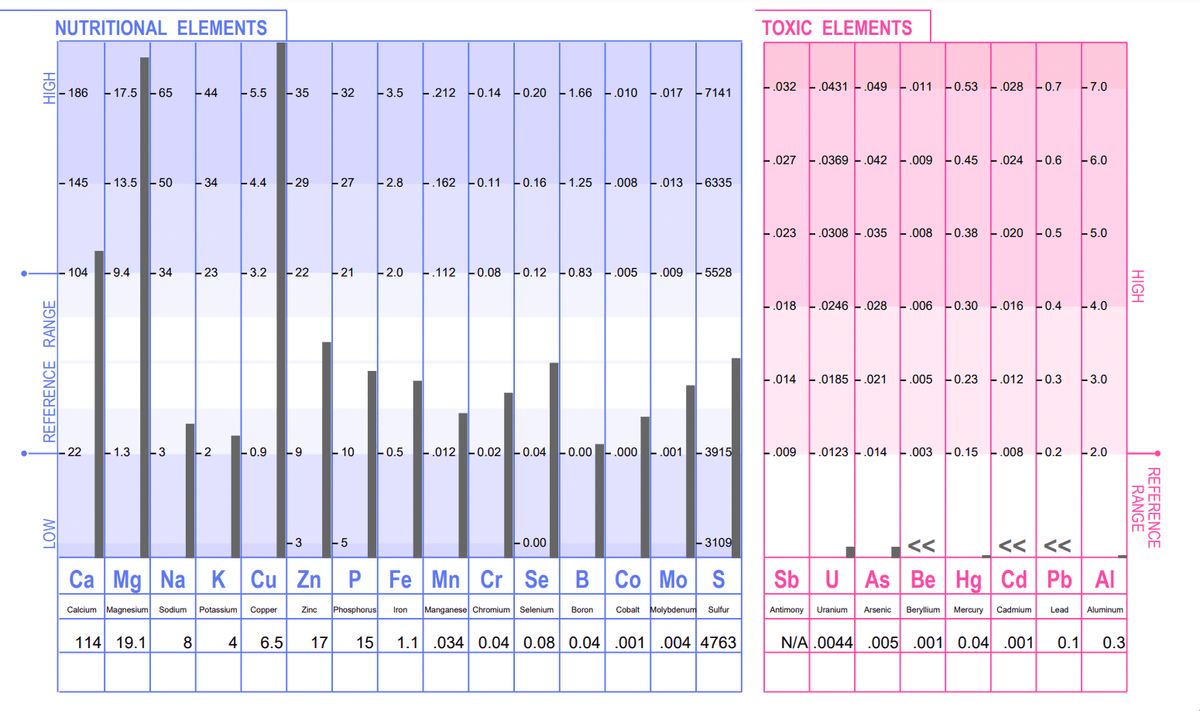What Is a Hair Tissue Mineral Analysis (HTMA)?
A Hair Tissue Mineral Analysis (HTMA) is a simple, non-invasive test that uses a small sample of your hair to measure the levels of key minerals and metals in your body. Because hair is a soft tissue, it reflects what’s happening inside your cells over time — kind of like a long-term “report card” of your mineral status. It tends to save ~3 months worth of "data" from your body (unlike blood, which is constantly cycling in and out at all times).
This lab test can detect 20+ minerals and trace elements with impressive accuracy (within about 3%). That’s similar — and sometimes even better — than standard blood testing.
It’s important to know that not all labs are created equal. Many wash hair samples before testing, which can strip away minerals and skew results. For the most accurate data, the hair sample should remain unwashed at the lab so your natural mineral readings stay intact.

*note: this image shows quite a large chunk of hair being chopped - but it isn't usually all from the SAME section of your head*
What Can an HTMA Reveal?
HTMA gives a deep look at how your body is functioning at the cellular level — not just what’s happening in your bloodstream today, but what’s been building up or depleting over weeks and months. Here’s what this type of testing can reveal:
- Lifestyle Imbalances: The test can show how stress, sleep, emotional strain, or even exposure to personal care products (like aluminum in deodorant or heavy metals in hair dye) might be affecting your health.
- Dietary Clues: HTMA can uncover signs of low protein intake, too many processed carbs, or even mineral-depleting foods and drinks. It can also show signs of heavy metals from sources like fish (mercury) or certain teas (nickel).
- Metabolic Type & Energy Levels: By reading specific mineral ratios, practitioners can assess your metabolism — whether your body runs “fast” or “slow” — and your overall energy production. This can help explain fatigue, mood changes, or sluggish digestion.
- Thyroid & Adrenal Function: Certain mineral patterns reflect how well your adrenal and thyroid glands are performing, giving insight into stress resilience, hormonal balance, and metabolism.
- Blood Sugar & Carbohydrate Tolerance: HTMA can reveal imbalances related to blood sugar regulation and insulin sensitivity.
- Toxic Metal Exposure: While no test can detect every toxin, HTMA is one of the best ways to assess stored heavy metals like mercury, lead, aluminum, and cadmium.
- Stress Response & Emotional Health: HTMA patterns often reflect chronic stress and even emotional states such as anxiety or burnout. Because mineral balance directly affects the nervous system, it’s often used to help support mental and emotional wellness.
- Long-Term Health Trends: One of the most powerful uses of HTMA is prevention — spotting trends that may predict future health challenges months or even years before they show up as symptoms.
How We Would Use Your HTMA Results
Once your results are in, a trained practitioner looks for specific mineral patterns and ratios that reveal how your body is adapting to stress, how efficiently you’re producing energy, and where your mineral imbalances lie. A few key assessments include:
- The “Four Lows” Pattern: When calcium, magnesium, sodium, and potassium are all below ideal levels, it can point to chronic fatigue or burnout.
- Oxidation Rate: By comparing certain mineral ratios, your practitioner can tell if your metabolism is running too fast, too slow, or somewhere in between — a major clue for customizing diet and supplementation.
- Sodium/Potassium Ratio: This “stress ratio” helps identify inflammation, infection, blood sugar issues, or emotional tension.
- Calcium/Magnesium Ratio: Sometimes called the “lifestyle ratio,” this reflects balance between structure (calcium) and relaxation (magnesium) — revealing how well your body adapts to stress.
From there, the practitioner can fine-tune nutrition, supplements, and lifestyle recommendations to rebalance your body’s mineral system — helping to restore steady energy, clear thinking, balanced mood, and better resilience to stress.
